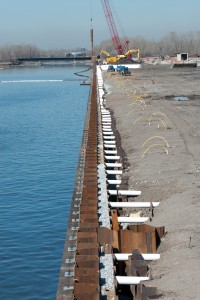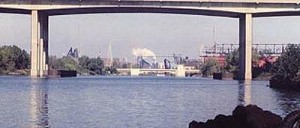Editor’s note: Areas of Concern are one of the issues that will be discussed Oct. 11-14 in Detroit at the 2011 Great Lakes Week. Detroit Public Television is providing ongoing coverage of Great Lakes Week at greatlakesnow.org
 A Great Lakes shipping canal scheduled to be dredged next spring has toxic chemicals deep below the surface, according to a recent study.
A Great Lakes shipping canal scheduled to be dredged next spring has toxic chemicals deep below the surface, according to a recent study.
Polychlorinated biphenyls (PCBs) were found between six to nine feet below the surface at two locations in the Indiana Harbor and Ship Canal in East Chicago, Ind.
PCBs were produced in the U.S. for 50 years before they were banned in 1979. The man-made chlorinated hydrocarbons are highlytoxic. Exposure can lead to cancer, weakened immune systems, reproductive and brain problems, according to the Environmental Protection Agency.

The Indiana Harbor and Ship Canal is scheduled to be dredged in spring 2012. Photo: U.S. Army Corps of Engineers - Chicago District
PCBs were already well documented in the sediment surfaces in the canal, but the deeper chemicals create new worries.
“We found that concentrations are higher below the surface than on the surface,” said Keri Hornbuckle, professor at the University of Iowa’s College of Engineering and coauthor of the study. “This especially becomes a problem if they want to dredge.”
And that’s exactly what the U.S. Army Corps of Engineers wants to do. The heavily used canal in an economically depressed area hasn’t been dredged since the 1970s. There was nowhere to put the contaminated sediment. But now the corps is building a disposal facility in East Chicago. It will be completed by the end of the year, said Dan Wethington, project manager at the U.S. Army Corps of Engineers Chicago District.
Hornbuckle fears the dredging could release the buried PCBs.
“How deep they dredge and what they leave behind will make a difference to the PCBs getting into Lake Michigan,” Hornbuckle said. “If they skim off the top meter, it could create a long-term, steady increase from the surface.”
The upcoming project is for navigational dredging, which is dredging without necessarily leaving the area cleaner than before. Environmental dredging leaves the area cleaner.
The corps has shown concern with contaminants in past cases, Hornbuckle said. But she fears a navigational dredge may stir up these recently found PCB deposits.
The agency is aware of its limitations, Wethington said.
“This is certainly not an environmental dredging project,” Wethington said. “If you’re looking to target removal, you have to go through a different department.”
But Wethington still believes the dredging will have environmental benefits.
“PCBs, for the most part, are absorbed by sediment, so we will be removing quite a bit of the chemicals,” Wethington said. “Will some remain? By all means, yes, but there are PCBs in the channel now.”
PCBs do not promptly break down and remain for long periods in air, water, and soil. The chemicals can be carried long distances and are found all over the world, according to the EPA. Despite the 1979 ban, they are still released from poorly maintained waste sites and leak from electrical transformers and other products.
One of the samples in the study had PCBs traced back to the 1930s.

The shipping canal connects the Grand Calumet River to Lake Michigan. Photo: EPA
The Indiana Harbor and Ship Canal connects the Grand Calumet River, which originates in Gary, Ind., to Lake Michigan. The river and canal were already on the radar for contamination and are listed as an Area of Concern. U.S. and Canadian officials have designated 43 areas with serious environmental problems in the Great Lakes and deemed them Areas of Concern, with increased clean up and monitoring efforts.
The Indiana Department of Environmental Management has two-remediation projects on the Grand Calumet River under the Great Lakes Legacy Act. The projects will remove contaminated sediment and cap the previously polluted areas, said Jim Smith, coordinator of the natural resource damage program at the Indiana Department of Environmental Management.
The Indiana Department of Environmental Management tried to find funding to environmentally dredge part of the canal.
“We did look at some environmental dredging on parts of the shipping canal but it would not be approved by the Army Corps headquarters,” Smith said. “The state withdrew from that project earlier this year because we were spending money and not getting anywhere.”
The canal and river run through the heavily industrialized northwest corner of Indiana. The chemicals in the canal are from industrial runoff, sewer overflows and direct industrial discharges, according to the EPA.
Wethington sees the project as a boost for the region.
“Dredging out contaminated sediment will be like a one-two punch in terms of benefits to both the economy and environment,” he said.
Hornbuckle recognizes the economic need for dredging. But she fears that navigational dredging will worsen regional contamination.
“They need to get barges in and I understand that,” she said. “We only tested two areas … they should find out where all the PCBs are before they dredge, or discharge into Lake Michigan will likely increase.”
I really think yhu shuld hav included the definition of dredging
Pingback: Great Lakes Week 2011 | Great Lakes Echo